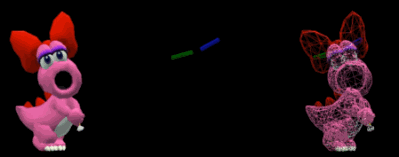 A Super Mario variety blog.
Screenshots, photos, sprites, gifs, scans and more from all around the world of Super Mario Bros.
A Super Mario variety blog.
Screenshots, photos, sprites, gifs, scans and more from all around the world of Super Mario Bros.



- Links
In Super Mario World, the respawn system for enemies normally requires Mario to leave the screen and come back in order to cause a despawned enemy to respawn, like in the vast majority of other 2D platformers.
However, there is a peculiarity in this game whereby if Mario is a specific amount of pixels away from an enemy’s spawn point, the enemy will both be considered close enough to spawn (and move in from offscreen) and also far enough that respawning it does not require Mario to first move away and then come back. Essentially, the enemy keeps respawning and moving in from off-screen and behaving like an infinite enemy generator (e.g. like a pipe spawning Goombas) despite actually only being a single enemy.
This can be used to farm infinite 1-Ups from a single enemy if Mario is positioned correctly, as seen in the footage. The Green Koopa Paratroopa coming in from the left is the same one every time respawning due to the oversight described above. Note also the paradox that it creates in the last loop where it respawns while the shell-less version of it from the last spawn is still alive, cloning itself.
Main Blog | Patreon | Twitter | Bluesky | Small Findings | Source: octavesmw
Three-page fold-out from a 1997 Nintendo of America’s press kit, featuring a cropped Super Mario 64 render with the caption “the biz”.
Main Blog | Patreon | Twitter | Bluesky | Small Findings | Source: TheUltiMarioFan
Luigi’s Mansion 3’s object interaction physics have many quirks that express themselves as occasional erratic movement.
A particularly bizarre example can be found in the Blooming Suite on Floor 7, where it is possible to move the glowing flowers away from their stems using other items, whereupon they will jump back to their regular locations when freed. Any furniture they interact with has a chance to start jumping around wildly, as seen with the table in the footage.
Main Blog | Patreon | Twitter | Bluesky | Small Findings | Source: hyper_lexus
In Super Mario Galaxy, the “Plunder the Purple Coins” mission in Deep Dark Galaxy puts the player in the cave with the ship, and blocks the exit so that the rest of the galaxy cannot be explored.
However, using a combination of glitches, it is possible to clip out of the cave and access the outdoor areas of the planetoid. Curiously, NPCs can be found there, likely leftovers from development. Near the surface of the water, the green Toad from the Toad Brigade (later known as Banktoad) can be found spinning around.
Banktoad literally has nothing to say, producing a single blank speech bubble when interacted with.
Main Blog | Patreon | Twitter | Bluesky | Small Findings | Source: usernameispassword
“Rocky Wrench in a Flintstones-style car” miniboss found in a prototype version of Yoshi’s Island, but removed from the finished version.
Note how after being hit twice, the stone wheels fall off the car and the Rocky Wrench runs around while carrying the body of the car for the final phase.
Main Blog | Patreon | Twitter | Bluesky | Small Findings | Source: Alieneer_TF2
The Nintendo Switch version of Paper Mario: The Thousand-Year Door introduces a character design inconsistency that was not present in the original GameCube version.
Top: in the original, X-Nauts only had back sprites when they are audience members, which shows their suits having no X designs on the back, and instead a zipper. This is retained in the Switch version.
Bottom: however, in the Switch version, Peach can be seen from the back while in her X-Naut disguise, which shows no zipper, and the same X design as in the front, no longer matching the audience X-Nauts.
Note that Peach’s disguise is portrayed as perfect in the story, and as such can not be reasonably argued to somehow look different from regular X-Nauts from the back. As the sprites for other audience members also have minor color/shape differences from the regular sprites in this version, the most likely explanation is that there was not enough communication between the art team members responsible for overworld sprites and the ones responsible for the audience to ensure consistency between the designs.
Main Blog | Patreon | Twitter | Bluesky | Small Findings | Source: PM:TTYD, Switch
Top: in Mario Superstar Baseball, there is a blue stick and a green stick hidden inside Birdo’s bow. This can not be seen in-game and requires external camera tools to zoom in and view.
Bottom: a comparison of Birdo’s normal model, the sticks, and the model in wireframe with the sticks visible. The internal names for the sticks are “Bip01 Îßưð٠1” for the green one, and “Bip01 Îßưð٠2” for the blue one.
It is most likely that these were leftovers from a point during the modeling process where they were used to aid positioning the bow correctly, and were simply overlooked when the model was cleaned up for the finished version.
Main Blog | Patreon | Twitter | Bluesky | Small Findings | Source: Geno Penguin













